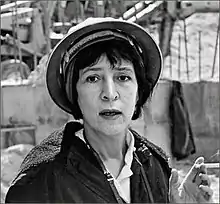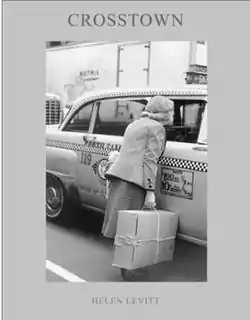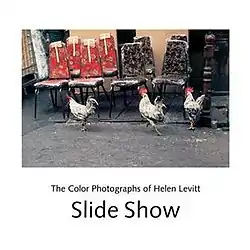Helen Levitt
Helen Levitt (August 31, 1913 – March 29, 2009)[1][2] was an American photographer. She was particularly noted for street photography around New York City, and has been called "the most celebrated and least known photographer of her time."[3]
Helen Levitt | |
|---|---|
 1963 | |
| Born | August 31, 1913 Brooklyn, New York, United States |
| Died | March 29, 2009 (aged 95) New York, New York, United States |
| Nationality | American |
| Known for | Photography |


Early life and career
Levitt was born in Bensonhurst, Brooklyn, New York,[1] the daughter of May (Kane), who was a bookkeeper before her marriage, and Sam Levitt, who ran a wholesale knit-goods business.[1][4] Her father and maternal grandparents were Russian Jewish immigrants.[5] She dropped out of high school[6] and in 1931 she learned how to develop photos in the darkroom when she began working for J. Florian Mitchell, a commercial portrait photographer in the Bronx.[4][7] She saw the work of Henri Cartier-Bresson, a large influencer on her career, at the Julien Levy Gallery and for the first time saw photography as art.[8][9] She practiced by photographing her mother’s friends with a used Voigtländer camera.[1]
While teaching art classes to children in the mid-1930s, Levitt became intrigued with the transitory chalk drawings that were part of the New York children's street culture of the time.[10][11] She purchased a Leica camera (with a right-angle viewfinder) and began to photograph these chalk drawings, as well as the children who made them.[12] The resulting photographs were ultimately published in 1987 as In The Street: chalk drawings and messages, New York City 1938–1948.[13]
She continued taking more street photographs mainly in East Harlem but also in the Garment District and on the Lower East Side, all in Manhattan.[14] During the 1930s to 1940s, the lack of air conditioning meant people were outside more, which invested her in street photography.[15] Her work was first published in the Fortune magazine's July 1939 issue.[16]
Levitt received her first grant in 1946 from the Museum of Modern Art in New York.[17] In 1959 and 1960, she received two grants from Guggenheim Foundation for her pioneering work in color photography.[18] In 1965 she published her first major collection, A Way of Seeing.[19] Much of her work in color from 1959 to 1960 was stolen in a 1970 burglary of her East 12th Street apartment. The remaining photos, and others taken in the following years, can be seen in the 2005 book Slide Show: The Color Photographs of Helen Levitt.[20] However, she felt equally comfortable working with black and white, as she did both in the 1980s. In 1976, she was a Photography Fellow of the National Endowment for the Arts.[21]
Connections to other artists
Levitt's influence from Cartier-Bresson was not only from viewing his work in galleries, but also once accompanying him on a day of shooting in New York City.[22]
Levitt also had a known connection with Walker Evans. In 1937 or 1938, she showed him her photographs of children playing. He found interest in them, and they worked together in 1938-39, taking pictures in the subway. It has been written that “the only photographers Evans ‘felt had something original to say were Cartier-Bresson, Helen Levitt and himself.’”
On the same day that she showed her photographs to Evans, she met James Agee, who was an influence on her and also introduced her to poker. The two of them worked along with Janice Loeb, later her sister-in-law,[22] on documentary films. Loeb also introduced Levitt to Luis Buñuel, whom she had her first film job with as an editor. Jeff Rosenheim, whom Levitt met at a showing of her work in Yale, also became a friend and joined her poker group. She was also friends with Thomas Roma, the director of the photography program at Columbia University for nearly 25 years.[15]
Later life and death
Levitt lived in New York City and remained active as a photographer for nearly 70 years. However, she expressed lament at the change of New York City scenery:
"I go where there's a lot of activity. Children used to be outside. Now the streets are empty. People are indoors looking at television or something."[18]
She had to give up making her own prints in the 1990s due to sciatica, which also made standing and carrying her Leica difficult, causing her to switch to a small, automatic Contax. She was born with Meniere’s syndrome, an inner-ear disorder that caused her to “[feel] wobbly all [her] life.” She also had a near-fatal case of pneumonia in the 1950s.[1] Levitt lived a personal and quiet life. She seldom gave interviews and was generally very introverted. She never married, living alone with her yellow tabby Blinky[15] until, at the age of 95, she died in her sleep on March 29, 2009.[1]
Exhibitions
The new photography section of the Museum of Modern Art, New York included Levitt's work in its inaugural exhibition in July 1939.[23] In 1943, Nancy Newhall curated her first solo exhibition "Helen Levitt: Photographs of Children" there. A second solo exhibit, Projects: Helen Levitt in Color, was held at the Museum of Modern Art, New York in 1974.[24] Her next major shows were in the 1960s; Amanda Hopkinson suggests that this second wave of recognition was related to the feminist rediscovery of women's creative achievements.[23]
Selected retrospectives
- 1983: Street Portrait: The Photographs of Helen Levitt Museum of Fine Arts, Boston[25]
- 1985: Moderna Museet, Stockholm
- 1988: The Photographers' Gallery, London
- 1991: San Francisco Museum of Modern Art (toured nationally 1991–1993)[26]
- 1994: Diputación Provincial de Granada, Spain (and tour)
- 1997: International Center of Photography, New York[3]
- 2001: Centre national de la photographie, Paris
- 2007: Fondation Henri Cartier-Bresson, Paris
- 2008: Foam Fotografiemuseum Amsterdam
- 2008: Sprengel Museum, Hannover (Accompanied her award for the Spectrum International Photography Prize)
- 2010: PHotoEspaña, Madrid (and tour)
- 2018: Albertina Museum, Vienna
Bibliography
- Levitt, Helen; Agee, James (1989) [1965]. A Way of Seeing: Third Edition. Duke University Press. ISBN 978-0-8223-1005-1.
- Levitt, Helen; Coles, Robert (1987). In the Street: Chalk Drawings and Messages, New York City, 1938-1948. Duke University Press. ISBN 0-8223-0771-5.
- Levitt, Helen; Hambourg, Maria Morris; Phillips, Sandra S. (1991). Phillips, Sandra S. (ed.). Helen Levitt. San Francisco Museum of Modern Art. ISBN 0-918471-22-2.
- Levitt, Helen; Oles, James (1997). Helen Levitt: Mexico City. W. W. Norton & Company. ISBN 0-393-04549-8.
- Levitt, Helen; Prose, Francine (2001). Crosstown. powerHouse Books. ISBN 1-57687-103-7.
- Levitt, Helen; Gopnik, Adam (2004). Here and There. powerHouse Books. ISBN 1-57687-165-7.
- Levitt, Helen; Szarkowski, John (2005). Slide Show: The Color Photographs of Helen Levitt. powerHouse Books. ISBN 978-1-57687-252-9.
- Levitt, Helen; Evans, Walker (2008). Helen Levitt. powerHouse Books. ISBN 978-1-57687-429-5.
- Levitt, Helen; Trachtenberg, Alan; Chevrier, Jean-François; Ribalta, Jorge (2010). Helen Levitt: Lírica Urbana. La Fabrica Editorial. ISBN 978-84-92841-24-0.
- Levitt, Helen (2017). One, two, three, more. Introduction by Geoff Dyer. Brooklyn: PowerHouse.
- Levitt, Helen (2017). Manhattan Transit: The Subway Photographs of Helen Levitt. Introduction by David Campany. Galerie Thomas Zander and Verlag der Buchhandlung Walther König. ISBN 978-3-96098-122-0.
Filmography
In the late 1940s, Levitt made two documentary films with Janice Loeb and James Agee: In the Street (1948) and The Quiet One (1948). Levitt, along with Loeb and Sidney Meyers, received an Academy Award nomination for The Quiet One. Levitt was active in film making for nearly 25 years; her final film credit is as an editor for John Cohen's documentary The End of an Old Song (1972).[28] Levitt's other film credits include the cinematography on The Savage Eye (1960),[29] which was produced by Ben Maddow, Meyers, and Joseph Strick, and also as an assistant director for Strick and Maddow's film version of Genet's play The Balcony (1963). In her 1991 biographical essay, Maria Hambourg wrote that Levitt "has all but disinherited this part of her work."[13] In 2012 Deane Williams published a comprehensive overview of Levitt's films in Senses of Cinema.[30]
List of films
- In the Street (1948): cinematographer and editor.
- The Quiet One (1948): cinematographer and writer.
- The Stairs (1950): producer.
- The Savage Eye (1960): cinematographer.
- The Balcony (1963): assistant director.
- An Affair of the Skin (1963): co-producer with Ben Maddow.
- In the Year of the Pig (1968): co-editor with Hannah Moreinis.[31]
- The End of an Old Song (1972): editor.
Awards
Levitt is a 2008 recipient of the Francis J. Greenburger Award for excellence in the arts.[27]
References
- Loke, Margaret (March 30, 2009). "Helen Levitt, Who Froze New York Street Life on Film, Is Dead at 95". The New York Times. Retrieved March 30, 2009.
- Rourke, Mary (April 1, 2009). "Helen Levitt dies at 95; New York street photographer of poignant dramas". Los Angeles Times. Retrieved April 1, 2009.
- Strauss, David Levi (October 1997). "Helen Levitt: International Center for Photography - exhibition". Artforum.
- "Levitt, Helen (1913—) | Encyclopedia.com". www.encyclopedia.com.
- https://www.familysearch.org/ark:/61903/1:1:MJR8-X2K
- Phaidon Editors (2019). Great women artists. Phaidon Press. p. 242. ISBN 978-0714878775.
- "The Economist". Economist Newspaper Limited. July 5, 2009 – via Google Books.
- "Helen Levitt". April 23, 2009 – via www.telegraph.co.uk.
- "Helen Levitt". Smithsonian American Art Museum.
- "Graffiti: Chalk Drawing of Figure with Double Pupils, New York City (ca. 1940)". Metropolitan Museum of Art.
- "Museum of Contemporary Photography". www.mocp.org.
- Peres, Michael R. (May 29, 2013). The Focal Encyclopedia of Photography. Taylor & Francis. ISBN 9781136106132 – via Google Books.
- Hambourg, Maria Morris (1991). "Helen Levitt: A Life in Part". In Phillips, Sandra S. (ed.). Helen Levitt. San Francisco Museum of Modern Art. pp. 45–63. ISBN 0-918471-22-2.
- Silverman, Rena (January 16, 2019). "Helen Levitt's Street Photos Blend the Poetic With the Political". The New York Times.
- "Helen Levitt". The Telegraph. 23 April 2009. Retrieved March 11, 2017.
- Gand, Elizabeth (September 1, 2009). "Helen Levitt (1913–2009) and the Camera". American Art. 23 (3): 98–102. doi:10.1086/649790.
- Times, Special To The New York (1977-05-15). "CAMERA VIEW". The New York Times. ISSN 0362-4331. Retrieved 2017-03-11.
- Loke, Margarett (2009-03-30). "Helen Levitt, Who Captured New York Street Life, Dies at 95". The New York Times. ISSN 0362-4331. Retrieved 2017-03-11.
- Levitt, Helen (1989). A Way of Seeing: Third Edition. Duke University Press. ISBN 978-0-8223-1005-1.
- Levitt, Helen (2005). Slide Show: The Color Photographs of Helen Levitt. powerHouse Books. ISBN 978-1-57687-252-9.
- "Helen Levitt". International Center of Photography. 2017-02-04. Retrieved 2017-03-11.
- Boxer, Sarah (April 8, 2004). "Capturing Little Dramas With a Click; Helen Levitt's Pictures Speak for Themselves". The New York Times. Retrieved March 11, 2017.
- Hopkinson, Amanda (April 3, 2009). "Obituary - Helen Levitt: Award-winning New York photographer noted for street scenes and social realism". The Guardian.
- "Projects: Helen Levitt in Color".
- Foresta, Merry A. (July 5, 1984). "Exposed and Developed: Photography Sponsored by the National Endowment for the Arts". National Museum of American Art – via Google Books.
- Kort, Carol; Sonneborn, Liz (May 14, 2014). A to Z of American Women in the Visual Arts. Infobase Publishing. ISBN 9781438107912 – via Google Books.
- "Helen Levitt" (PDF). Jackson Fine Art. Retrieved March 11, 2017.
- Mathews, Scott (2008-08-06). "John Cohen in Eastern Kentucky: Documentary Expression and the Image of Roscoe Halcomb During the Folk Revival". Southern Spaces.
- Jackson, Benjamin T. (Summer 1960). "The Savage Eye". Film Quarterly. 13 (4): 53–57. doi:10.1525/fq.1960.13.4.04a00160.
- Williams, Deane (March 2012). "Helen Levitt". Senses of Cinema (62). A critical review of Levitt's filmmaking career.
- Barsam, Richard Meran (1992). Nonfiction Film: A Critical History. Indiana University Press. p. 418. ISBN 978-0-253-20706-7.
Further reading
- Block, Melissa (January 17, 2002). "Helen Levitt's Indelible Eye". All Things Considered. National Public Radio. Radio program featuring an interview with Helen Levitt.
- Dikant, Thomas (2003). "Helen Levitt: 10 Photographs". Philologie in Netz. 25: 1–30. Archived from the original on 2009-03-30. Critical study of ten of Levitt's photographs. Dikant also discusses the influences on Levitt, including Henri Cartier-Bresson, Ben Shahn, and Walker Evans.
- Williamson, Marcus (April 17, 2009). "Helen Levitt: Photographer renowned for her portraits of street life in New York". The Independent.
- Smith, Joel (February 22, 2018). "People watching". The New York Review of Books. 65 (3): 22–24. Reviews One, two, three, more.
External links
![]() Media related to Helen Levitt at Wikimedia Commons
Media related to Helen Levitt at Wikimedia Commons
- Helen Levitt: New York Streets 1938 to 1990s at LensCulture
- Helen Levitt at IMDb. Note that there is occasionally confusion of Levitt's film credits with those of Helen Slote Levitt.